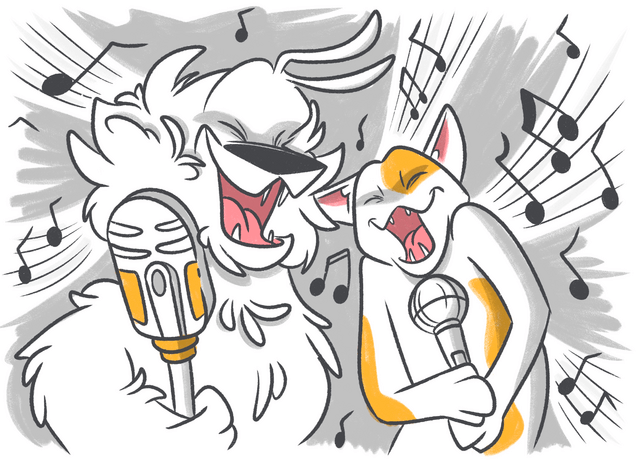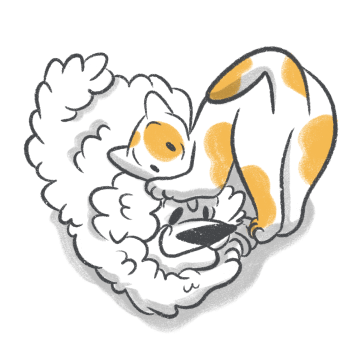A cat sound is not quite the same as a human word but can be no less informative. Animal scientists are finding more and more evidence backing up felines' advanced communication skills. Cats use body language and vocalizations to inform humans and other animals about their feelings and intentions. Still, it's often hard to decode them if you are moving on two feet.
What does it mean when a cat purrs or trills? Understanding your pet is essential when you are willing to become the best friend of your fluffy kid. You don't want to get scratched when trying to pet a hissing or growling cat as much as you don't want to scare away a cat who tries to greet you with purring and kneading joyfully.
Below is information about familiar cat sounds that are used when cats want to speak with us or each other.
Stop Googling - Ask a Real Vet
Content:
- Meowing
- Yowling or Howling
- Hissing
- Growling or Snarling
- Purring
- Trilling
- Chirping or Chattering
- Caterwauling
- Final Thoughts
Meowing
Meowing is the most common cat sounds used to communicate with humans. It can signify anything from hunger, a desire for attention, to the need for comfort.
Interestingly, meowing is not something cats do amongst themselves. You’ll have head kittens meowing for their mothers’ attention, but adult cats don’t meow at one another. Cats have learned over time that meowing is a good way of conversing with their humans.
Reasons cats meow:
- Greeting: A short, sharp meow sound is usually a form of greeting. The feline equivalent of "hey" or "hi." If your cat really missed you a great deal while you were gone, they might meow continuously for some time.
- A request: Young kittens usually emit a long, high-pitched meow sound to get their mom's attention. Your adult cat might try the same technique with you – a great honor as this means you've assumed mom status in your cat's eyes.
- Dissatisfaction: Cats often use a lower-pitch meow to show that we have displeased them somehow. Perhaps we moved them from their favorite sunny spot, or we omitted to throw their favorite toy mouse for them to chase. Either way, your cat is telling you off.
“But sometimes a cat meow can indicate anxiety, boredom, frustration, or even illness, particularly if it’s lower-pitched and more drawn out compared to the short, high-pitched meow that often signifies a greeting or a want,” writes Alison Gerken, a Clinical Behavior Resident.
If you wonder what your cat gets up to while you’re out, the Petcube Cam is one handy gadget you should not be without. The cam allows you to observe your cat's meowing in real-time or through recorded footage, helping you discern any patterns or areas of concern, whether at home or away. This insight is invaluable in responding to your cat's calls and strengthening the bond you share.
Yowling or Howling
Yowling or cat howling can be unsettling, as these cat sounds often indicate distress, territorial disputes, or mating calls. Yowling is a long, low-pitched, and throaty sound, often quite loud.
Distinguishing between a yowl for attention and one signaling distress is crucial. A good tip is to look at your cat’s body language and any other physical signals that accompany the cat yowling noise to determine the underlying cause.
“It’s a plaintif, kind of “I’m in trouble” sound," describes celebrity cat behaviorist and self-proclaimed Cat Daddy Jackson Galaxy.
Why do cats howl?
Ever wondered why cat’s yowl at night? This can be part of their mating behavior. Understanding the context and frequency of these sounds can guide you on how best to support and comfort your pet during times of need.
Hissing
A cat hissing is a clear sign that it is feeling threatened, scared, or irritated. It’s a defensive mechanism, showing discomfort with a situation or presence in their territory. This cat sound is usually accompanied by defensive body language – an arched back, puffed-up hair and tail, and pinned-back ears.
A cat hissing at you is an unmistakable invitation for you to back away. This cat is feeling threatened and afraid and is warning you that if you persist, you're in for a firm bite or scratch. You've been warned!
Your Petcube Cam 360 can be a great asset when it comes to identifying potential threats and stressors in your pet’s environment, even when you’re not physically there.
Growling or Snarling
Growling and snarling in cats is akin to a warning bell, indicating aggression, fear, or discomfort. Where a hiss or a yowl will come from a cat’s open mouth, a cat’s growl is usually an internal sound made with the mouth mostly closed. A cat growl may start and end with a yowl, frequently preceding a hiss.
Why do cats growl? These sounds can precede a physical confrontation if the cat feels cornered or provoked. For owners, recognizing these sounds as serious distress signals is critical to intervening before a situation escalates.
Purring
Purring is often associated with a cat in a state of utter contentment, but cats also purr when they’re in pain or distress. This duality makes understanding the context of purring important. A happy and content purr as your cat lounges on your lap differs vastly from a low, continuous purr from a cat that’s visibly unwell or injured, highlighting the need for attentive care.
Why do cats purr when they’re unwell or injured? A cat in pain may purr as a way to self-soothe. But the real magic of a cat purring lies in its healing properties. The low frequency at which the sound waves oscillate when your cat purrs is believed to promote bone and tissue growth and lessen pain and swelling.
Having an injured or unwell feline is distressing enough without facing the escalating emergency costs often involved in such situations. Petcube offers an affordable alternative to traditional pet insurance in the form of an Emergency Fund.
For less than $1 a day, you have access to up to $3000 a year to cover any emergency veterinary care for up to six pets. Every cat and dog can be covered, regardless of age, breed, or medical history.
The cover also includes convenient 24/7 online vet help to ensure pet-related questions are answered instantly and professionally. No more taking to Google, no more guessing and stressing. Just real-time answers by qualified veterinarians.
Follow the link and get an exclusive 27% discount for our blog readers.
Trilling
Cat trilling is a delightful sound, reminiscent of a rolled “r,” often used between cats, especially from mother to kitten, indicating a positive interaction. For owners, recognizing this sound can be reassuring.
Cat trilling is akin to a tinkling, joyous sound and is one of your cat's sweetest sounds. What does cat trilling mean? Well, that your cat is happy, of course!
Chirping or Chattering
Cat chirping is a gentle, fast-paced clicking sound produced by a cat chattering her teeth, often combined with a faint squeak or meow. Why do cats chatter?
- Predatory behavior: The most common place where you can hear a cat chirping would be a window sill with your cat chattering teeth while staring at a bird behind the glass. The chatter is caused by a combination of hunting instincts and frustration over being unable to catch the prey.
- Excitement: Cats can sometimes chirp out of excitement, mainly when you play with them, provoking their hunting behavior, for example, during games with a feather.
Caterwauling
Caterwauling is a unique, long, hollow kind of yowl produced by an unspayed female cat in heat.
Why do cats caterwaul?
- Mating issues: An unspayed female cat in heat would produce this sound to attract male cats. Caterwauling can be combined with anxious behavior, with your cat trying to escape the house to meet her mates, who usually gather in response to the sound.
Believe it or not, experienced cat parents will tell you that their four-legged friends communicate effortlessly with them. The more you observe your cats, the better you understand their mood and feelings, which is critical to a strong bond.
If you wonder how much your cat loves you, take this quiz and know where you stand.
Final Thoughts
Understanding cats' diverse sounds is crucial for providing a loving and responsive environment. Each sound, from a meow to a trill, holds valuable information about their emotional and physical well-being. Understanding your cat's vocalizations will ensure your feline friend feels understood and cherished.
Was this article helpful?
Help us make our articles even better










